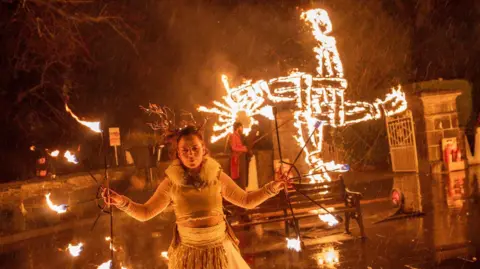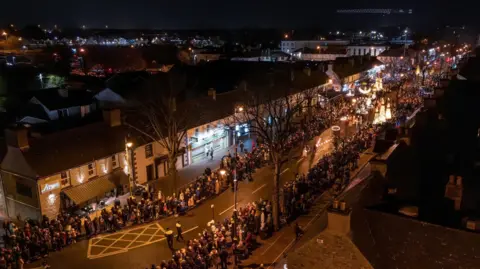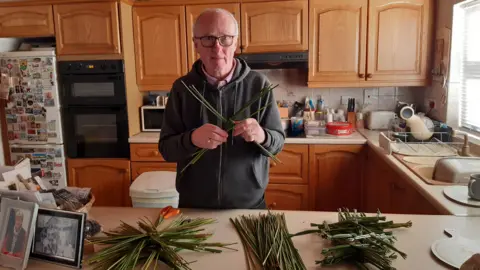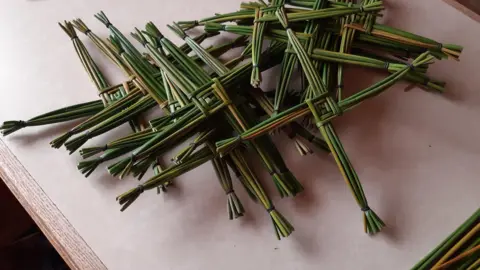How 'trailblazer' nun St Brigid continues to fascinate
 Kildare County Council/Allen Kiely
Kildare County Council/Allen KielySt Brigid's Day - today, Saturday 1 February - is traditionally marked by Catholic religious commemorations but recent years have seen a surge in interest for all things Brigid-themed.
The decision to introduce an Irish bank holiday to mark the day has helped spark a renewed interest in her legacy across the island, while thousands have been flocking to locations that claim links to the 5th Century nun.
One of those is in County Kildare, where St Brigid is credited with founding a monastery that became one of the most powerful sites in early Christian Ireland.
No mean feat for an early medieval woman in a country some consider to still be struggling with female representation in public life.
"Brigid is such a trailblazer; she really was a woman ahead of her time," said Paula O'Brien, co-organiser of Kildare's Spirit of Brigid festival.
It was launched in 2023, coinciding with the Republic's first ever St Brigid's Day bank holiday.
Last year, it attracted more than 80,000 visitors to Kildare and this year they hope to surpass that.
 Kildare County Council
Kildare County Council"We have groups coming from America, Canada, the UK. We have loads of people coming from all over Europe," Ms O'Brien told BBC News NI.
"We see it as an opportunity for tourism; we see it as an opportunity to celebrate our heritage and also for our communities to come together and really celebrate this iconic woman."
The bank holiday "definitely helps matters when everybody has an extra day to relax", she added.
Two years ago, the Social Democratic and Labour Party (SDLP) assembly member Cara Hunter called for St Brigid's Day to be marked with an extra bank holiday in Northern Ireland as well.
However, this was quickly shut down by the UK's Department of Business, Energy and Industrial Strategy because of the "considerable" cost to the economy.
 Kildare County Council/Allen Kiely
Kildare County Council/Allen KielyWho was St Brigid?
St Brigid is venerated as one of Ireland's three patron saints, alongside St Patrick and St Colmcille.
There are differing accounts of her origins, but one popular theory suggests she was born in Faughart, County Louth, near what is now the Irish border.
She became a very influential nun, founding a monastery for both men and women in Kildare.
St Brigid also founded the "church of the oak tree" - the Irish translation of which gave Kildare its name.
Few contemporary accounts her life survived, but hagiographies written a century after her death claimed she was a champion of the poor and a worker of miracles.
One of the more colourful claims was that Brigid turned bathwater into beer when she ran out of drink for her guests - a story mirroring the biblical Wedding of Cana.
Her feast day - 1 February - is the first day of spring in the ancient Celtic calendar.
 Kildare County Council
Kildare County CouncilThe Kildare festival is a mixture of concerts with well-known Irish artists, parades, exhibitions, workshops and pilgrim trails.
The organisers blended the secular with the spiritual because "Brigid means a lot of different things to a lot of different people".
"The values that Brigid championed 1,500 years ago are just as relevant today as they were back then," Ms O'Brien said.
"Her love of nature, equality and social justice, and peace - all of those messages are just as important now."
County Louth will celebrate its famous daughter with a multi-sensory light show in Dundalk and a candlelight procession through Faughart.
Commemorating St Brigid in Belfast
 Sean Lipfird
Sean LipfirdIreland's best-known female saint also has her own unique symbol - the St Brigid's cross.
Church and community groups will gather on Saturday to weave rushes into crosses in her memory.
They will include crafters at Belfast's 4 Corners Festival, which was set up to "weave connections" between different communities in the city.
Sean Lipfird, who is leading its crosses workshop in Newtownbreda Presbyterian Church, told BBC News NI that he has been "making them all week".
"I have 130 made, would you believe? And I've still rushes left."
His kitchen often resembles a "factory conveyor belt" in the lead up to St Brigid's Day, with crosses in various stages of manufacture.
"Some of those will be for friends that have asked me, but the bulk - say over 100 - will be going to the parish for distribution."
How do you make a St Brigid's cross?
 Sean Lipfird
Sean LipfirdMr Lipfird demonstrates the skill by taking a long rush in one hand and a second in his other hand.
He folds the second rush in two and wraps it tightly around the halfway point of the first rush, which remains full length.
This creates a T-shape which he turns 90 degrees so the folded rush points south.
"It's quite therapeutic," he said.
"You just keep folding and you're turning in a clockwise direction and gradually the cross develops."
He then lifts a third rush and folds that in half as well, wrapping it over the fold of the already bent rush to secure that one in place.
Turning it another 90 degrees, it is only when a fourth folded rush is added that it takes the shape of a crucifix.
"It's about keeping them neat. If you let (them) loose at all, they fall all over the place."
The final rush tucks inside the penultimate fold, and the four ends are bound with elastic and cut to an even length.
Mr Lipfird always uses 13 rushes to create a small cross, but adds there are "different shapes and varieties" to choose from.
"St Brigid's crosses have stretched far and wide, it's a lovely tradition."
